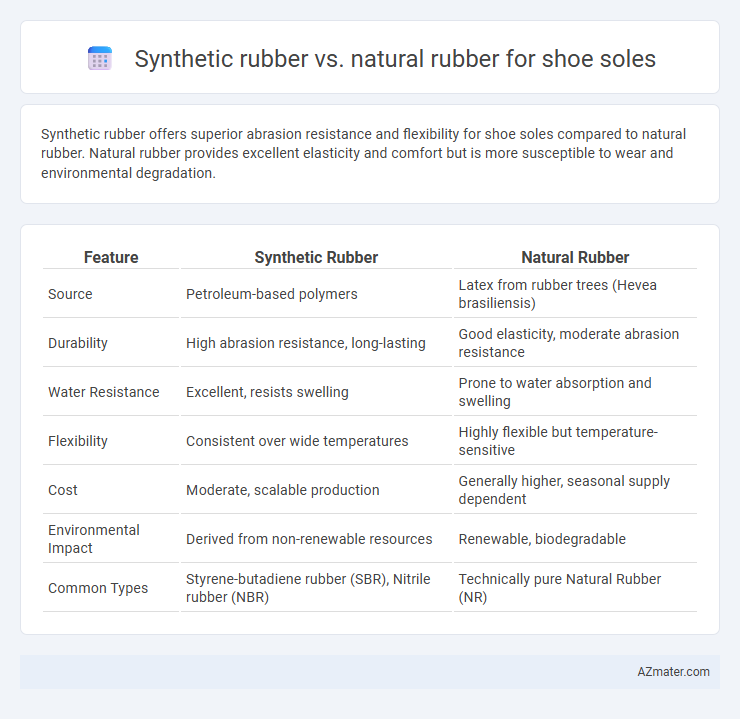Synthetic rubber offers superior abrasion resistance and flexibility for shoe soles compared to natural rubber. Natural rubber provides excellent elasticity and comfort but is more susceptible to wear and environmental degradation.
Table of Comparison
| Feature | Synthetic Rubber | Natural Rubber |
|---|---|---|
| Source | Petroleum-based polymers | Latex from rubber trees (Hevea brasiliensis) |
| Durability | High abrasion resistance, long-lasting | Good elasticity, moderate abrasion resistance |
| Water Resistance | Excellent, resists swelling | Prone to water absorption and swelling |
| Flexibility | Consistent over wide temperatures | Highly flexible but temperature-sensitive |
| Cost | Moderate, scalable production | Generally higher, seasonal supply dependent |
| Environmental Impact | Derived from non-renewable resources | Renewable, biodegradable |
| Common Types | Styrene-butadiene rubber (SBR), Nitrile rubber (NBR) | Technically pure Natural Rubber (NR) |
Introduction to Synthetic and Natural Rubber
Synthetic rubber is a man-made polymer derived from petroleum-based monomers such as styrene and butadiene, designed to offer enhanced durability, abrasion resistance, and chemical stability for shoe soles. Natural rubber, harvested from the latex of rubber trees (Hevea brasiliensis), provides excellent elasticity, resilience, and comfortable cushioning but is more prone to degradation in harsh conditions. Both materials are selected based on performance needs, with synthetic rubber favored for high-wear applications and natural rubber valued for its eco-friendly and flexible properties.
Key Properties of Synthetic Rubber
Synthetic rubber used in shoe soles offers superior abrasion resistance, enhanced durability, and better resistance to oil, heat, and chemicals compared to natural rubber. Its consistent molecular structure ensures uniform performance, improved flexibility, and excellent aging characteristics, making it ideal for high-performance footwear. Key synthetic rubbers like styrene-butadiene rubber (SBR) and nitrile rubber (NBR) are preferred for their balance of toughness, grip, and cost-effectiveness in shoe sole manufacturing.
Key Properties of Natural Rubber
Natural rubber offers superior elasticity, excellent abrasion resistance, and outstanding tensile strength, making it ideal for durable and flexible shoe soles. Its natural resilience provides enhanced comfort and shock absorption, important for prolonged wear and impact protection. High resistance to wear, tear, and environmental factors such as water and heat distinguishes natural rubber as a preferred material for high-performance footwear.
Durability: Synthetic vs. Natural Rubber Soles
Synthetic rubber soles offer superior durability compared to natural rubber soles due to enhanced resistance to abrasion, weathering, and chemicals. Natural rubber provides excellent flexibility and grip but tends to degrade faster under extreme heat and UV exposure. For long-lasting shoe soles, synthetic rubber is preferred in demanding environments where extended wear and resistance to elements are critical.
Comfort and Flexibility Comparison
Synthetic rubber offers superior flexibility and consistent cushioning, making it ideal for shoe soles that require enhanced comfort during prolonged wear. Natural rubber excels in elasticity and provides excellent shock absorption, contributing to a comfortable fit that adapts well to foot movements. Combining both materials can optimize sole performance by balancing durability, comfort, and flexibility for various footwear applications.
Traction and Grip Performance
Synthetic rubber compounds used in shoe soles typically offer superior traction and grip performance compared to natural rubber, primarily due to enhanced abrasion resistance and engineered tread patterns. Natural rubber provides excellent elasticity and stickiness, which contributes to strong grip on wet surfaces but may degrade faster under high wear conditions. Advanced synthetic formulations optimize traction on diverse surfaces, making them preferred for athletic and outdoor footwear applications requiring durable and reliable grip.
Environmental Impact and Sustainability
Synthetic rubber, derived from petrochemicals, has a significant environmental footprint due to fossil fuel extraction and non-biodegradability, contributing to long-term pollution in shoe soles. Natural rubber, harvested sustainably from rubber trees, offers biodegradability and carbon sequestration benefits, making it a greener alternative for eco-friendly footwear production. However, natural rubber's susceptibility to deforestation and land use changes demands responsible sourcing to ensure overall sustainability in shoe sole manufacturing.
Cost and Economic Factors
Synthetic rubber shoe soles typically offer lower production costs due to scalability and consistent raw material supply, making them economically favorable for mass manufacturing. Natural rubber soles, while often preferred for their superior elasticity and environmental benefits, incur higher expenses linked to raw material variability and supply chain dependencies. Cost efficiency in synthetic rubber drives widespread adoption in budget-conscious footwear markets, whereas natural rubber remains a premium choice with price premiums justified by durability and sustainability factors.
Common Applications in Footwear
Synthetic rubber, such as styrene-butadiene rubber (SBR) and neoprene, is widely used in shoe soles for its durability, resistance to abrasion, and cost-effectiveness, making it ideal for athletic and industrial footwear. Natural rubber provides superior elasticity and grip, commonly preferred in casual and outdoor shoes where comfort and traction are crucial. Both materials are often combined to optimize performance characteristics for different types of footwear applications.
Choosing the Right Sole: Synthetic or Natural Rubber?
Choosing the right sole for shoes depends on factors like durability, flexibility, and environmental impact. Synthetic rubber offers superior abrasion resistance and water resistance, making it ideal for heavy-use and wet conditions, while natural rubber provides excellent elasticity and eco-friendliness due to its biodegradable nature. Evaluating the specific shoe application ensures selection between synthetic rubber's longevity and natural rubber's comfort and sustainability benefits.

Infographic: Synthetic rubber vs Natural rubber for Shoe sole
 azmater.com
azmater.com